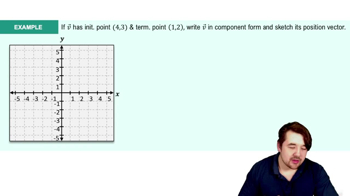Table of contents
- 0. Fundamental Concepts of Algebra3h 29m
- 1. Equations and Inequalities3h 27m
- 2. Graphs1h 43m
- 3. Functions & Graphs2h 17m
- 4. Polynomial Functions1h 54m
- 5. Rational Functions1h 23m
- 6. Exponential and Logarithmic Functions2h 28m
- 7. Measuring Angles40m
- 8. Trigonometric Functions on Right Triangles2h 5m
- 9. Unit Circle1h 19m
- 10. Graphing Trigonometric Functions1h 19m
- 11. Inverse Trigonometric Functions and Basic Trig Equations1h 41m
- 12. Trigonometric Identities 2h 34m
- 13. Non-Right Triangles1h 38m
- 14. Vectors2h 25m
- 15. Polar Equations2h 5m
- 16. Parametric Equations1h 6m
- 17. Graphing Complex Numbers1h 7m
- 18. Systems of Equations and Matrices3h 6m
- 19. Conic Sections2h 36m
- 20. Sequences, Series & Induction1h 15m
- 21. Combinatorics and Probability1h 45m
- 22. Limits & Continuity1h 49m
- 23. Intro to Derivatives & Area Under the Curve2h 9m
14. Vectors
Vectors in Component Form
Struggling with Precalculus?
Join thousands of students who trust us to help them ace their exams!Watch the first videoMultiple Choice
If vectors v⃗=⟨4,1⟩, u⃗=⟨−8,3⟩, and w⃗=⟨−2,−1⟩, calculate w⃗−3(v⃗+u⃗).
A
⟨10,13⟩
B
⟨−14,13⟩
C
⟨−14,−13⟩
D
⟨10,−13⟩
 Verified step by step guidance
Verified step by step guidance1
Start by calculating the sum of vectors v⃗ and u⃗. Add the corresponding components of the vectors: ⟨4, 1⟩ + ⟨−8, 3⟩.
Perform the addition of the components: (4 + (-8)) for the x-component and (1 + 3) for the y-component, resulting in the vector ⟨-4, 4⟩.
Next, multiply the resulting vector ⟨-4, 4⟩ by the scalar 3. Multiply each component of the vector by 3: 3 * ⟨-4, 4⟩.
Calculate the scalar multiplication: (3 * -4) for the x-component and (3 * 4) for the y-component, resulting in the vector ⟨-12, 12⟩.
Finally, subtract the vector ⟨-12, 12⟩ from vector w⃗ ⟨−2, −1⟩. Perform the subtraction component-wise: (-2 - (-12)) for the x-component and (-1 - 12) for the y-component, resulting in the final vector.

 3:55m
3:55mWatch next
Master Position Vectors & Component Form with a bite sized video explanation from Patrick
Start learningRelated Videos
Related Practice







